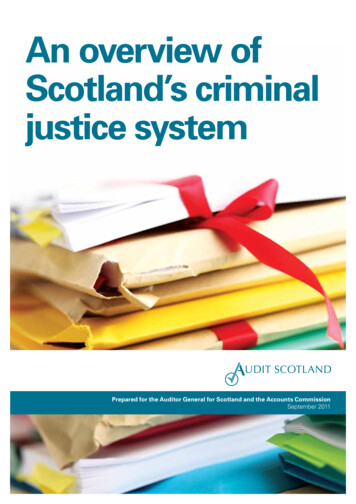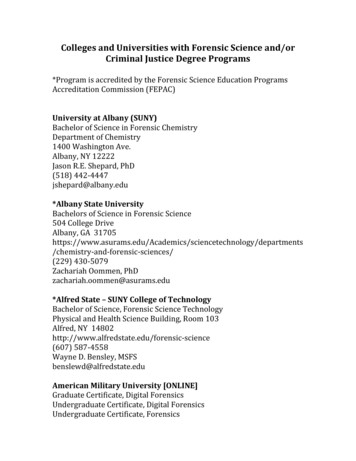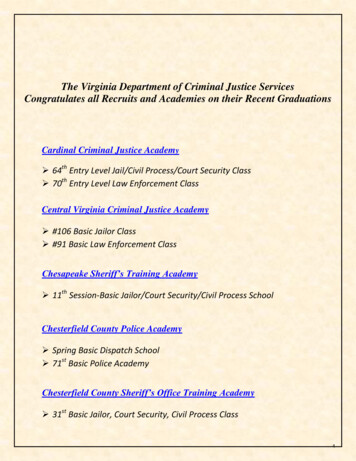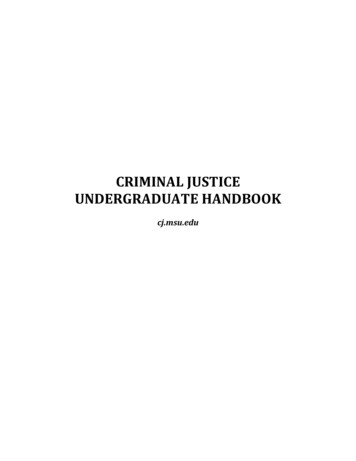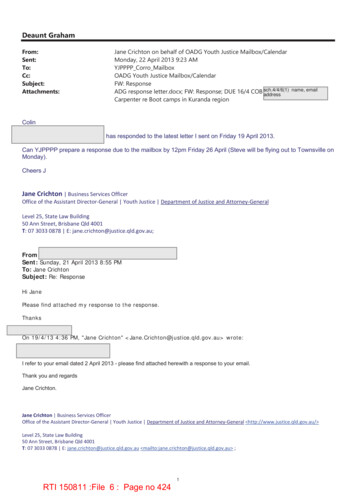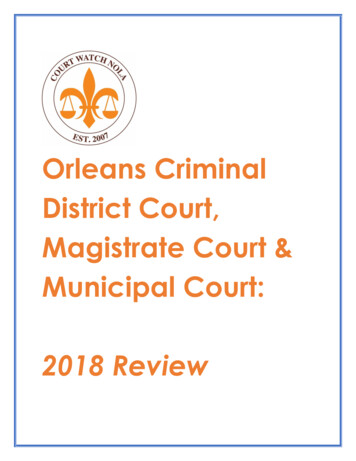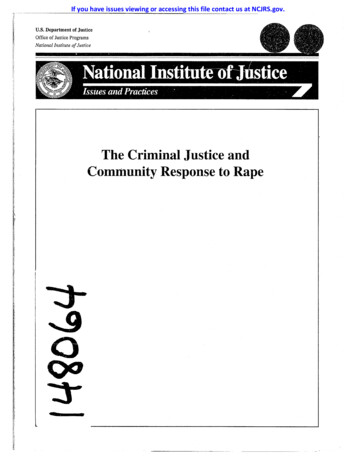
Transcription
If you have issues viewing or accessing this file contact us at NCJRS.gov.-;.('\U.S. Department of JusticeOffice of Justice ProgramsNational Institute of JusticeThe Criminal Justice andCommunity Response to Rape
About the National Instituteof JusticeThe National Institute of Justice (NiJ), a component of theOffice of Justice Programs, is the research and developmentagency of the U.S. Department of Justice. NIJ was established to prevent and reduce crime and to improve thecriminal justice system. Specific mandates established byCongress in the Omnibus Crime Control and Safe Streets Actof 1968, as amended, and the Anti-Drug Abuse Act of 1988direct the National Institute of Justice to:The research and development program that resulted inthe creation of police body armor that has meant thedifference between life and death to hundreds of policeofficers.Sponsor special projects, and research and development programs that will improve and strengthen theThe evaluation of innovative justice programs to determine what works, including drug enforcement, community policing, community anti-drug initiatives, prosecution of complex drug cases, drug testing throughout thecriminal justice system, and user accountability programs.criminal justice system and reduce or prevent crime.Conduct national demonstration projects that employinnovative or promising approaches for improving criminal justice.Develop new technologies to fight crime and improvecriminal justice.Evaluate the effectiveness ofcrim inaljustice programsand identify programs that promise to be successful ifcontinued or repeated.Recommend actions that can be taken by Federal, State,and local governments as well as by private organizations to improve criminal justice.Carry out research on criminal behavior.Develop new methods of crime prevention and reduc-tion of crime and delinquency.The National Institute of Justice has a long history ofaccomplishments, including the following:Basic research on career criminals that led to development of special police and prosecutor units to deal withrepeat offenders.Research that confirmed the link between drugs andcrime.Pioneering scientific advances such as the research anddevelopment of DNA analysis to positively identifysuspects and eliminate the innocent from suspicion.Creation of a corrections information-sharing systemthat enables State and local officials to exchange moreefficient and cost-effective concepts and techniques forplanning, financing, and constructing new prisons andjails.Operation ofthe world's largest criminal justice information clearinghouse, a resource used by State and localofficials across the Nation and by criminal justice agencies in foreign countries.The Institute Director, who is appointed by the President andconfirmed by the Senate, establishes the Institute's objectives, guided by the priorities of the Office of Justice Programs, the Department of Justice, and the needs of thecriminaljustice field. The Institute actively solicits the viewsofcriminaljustice professionals to identify their most criticalproblems. Dedicated to the priorities of Federal, State, andlocal criminal justice agencies, research and development atthe National Institute of Justice continue to search for answers to what works and why in the Nation's war on drugsand crime.fI
U.S. Department of JusticeOffice of Justice ProgramsNational Institute of JusticeThe Criminal Justice andCommunity Response to RapebyJoel Epstein, Esq.andStacia Langenbahn148064U.S. Department of JusticeNational Institute of JusticeThis document has been reproduced exactly as received from theperson or organization originating it. Points of view or opinions stated inthis document are those of the authors and do not necessarily representthe official position or policies of the National Institute of Justice.iila'Domain/OJP/NIJPermission to reproduce thisg icmaterial has beenu . S. Department of Justiceto the National Criminal Justice Reference Service (NCJRS).Further reproduction outside of the NCJRS system requires permissionof the @!IIIIII!I owner.May 1994Issues and Practices in Criminal Justice is a publication series of the National Institute of Justice.Each report presents the program options and management issues in a topic area, based on areview of research and evaluation finding's, operational experience, and expert opinion on thesubject. The intent is to provide information to make informed choices in planning, implementing, and improving programs and practice in criminal justice.
-------.----------------------------------National Institute of JusticePaul CascaranoAssistant DirectorCheryl CrawfordCarolyn PeakeNIJ Program MonitorsAdvisory PanelBarry Burkhart, Ph.D.Department of Psychology4082 Haley CenterAuburn UniversityAuburn, AL 36849-350!Police Chief Robert P. Owens, Ret.1744 Fisher CourtOxnard, CA 93035Mary Harvey, Ph.D., DirectorVictims of Violence ProgramCambridge City Hospital1493 Cambridge StreetCambridge, MA 02139The Honorable Leslie Crocker SnyderSupreme Court, Criminal TermPart 72100 Centre Street, Room 411New York, NY 10013Prepared for the National Institute of Justice, U.S. Department of Justice, by Abt Associates Inc.,under contract #OJP-89-C-009. Points of view or opinions stated in this document are those ofthe authors and do not necessarily represent the official position or policies of the U.S.Department of Justice.The National Institute of Justice is a component of the Office of Justice Programs, which also includes the Bureau ofJustice Assistance, the Bureau of Justice Statistics, the Office of Juvenile Justice and Delinquency Prevention, and theOffice for Victims of Crime.
ForewordGrowing awareness of the dimensions of the problem ofsexual assault has spurred significant changes in the investigation and prosecution of these crimes. Victims' advocates,rape crisis centers, and criminal justice practitioners haveworked to ease the burdens placed on victims of sexualassault.medical evidence is collected. Some jurisdictions fund themedical exam for victims. Expanding prevention efforts inthe community is another priority for stemming sexualassault, child sexual abuse, and domestic violence.This report describes recent key reforms adopted in somejurisdictions, such as protecting the anonymity ofthe victimand allowing complainants to report sexual assault evenwhen the victim chooses not to press charges. Law enforcement officials and district attorneys have worked to supportcompensation for victims and also have created victimwitness advocate positions to help victims navigate thecriminal justice process and speed their recovery.In reviewing approaches involving these strategies in anumber of jurisdictions, this report represents one effort bythe National Institute of Justice (NIJ) to provide informationof practical utility to victim services providers andpolicymakers to better address the needs of rape victims. Theresults of this and other NIJ research is also shared with ourcompanion agency in the Justice Department, the Office forVictims of Crime, to support development of programs oftangible benefit to those victimized by sexual assault andother crimes.Criminal justice agencies have expanded their initiativeswith victims to reach out to those who have been unaware orunable to obtain the care and services they need-such asminority communities and immigrants. They also have initiated and strengthened coordination with hospitals whereActing DirectorNational Institute of JusticeCarol V. PetrieForewordiii
AcknowledgementsThis report would not have been possible without the generous cooperation of the many people in Boulder, Denver,Philadelphia, st. Paul, Seattle, and elsewhere whom weinterviewed during the course of the study. We wish toacknowledge as well the support of our advisors, Dr. BarryBurkhart of Auburn University; Dr. Mary Harvey, Directorand Co-Founder ofthe Victims of Violence Program at theCambridge Hospital; Retired Chief Robert Owens of theOxnard (California) Police Department; and the HonorableLeslie Crocker Snyder of the New York State SupremeCourt, Criminal Term. Special thanks are due to our monitorsat the National Institute of Justice, Cheryl Crawford andCarolyn Peake. Both Ms. Crawford and Ms. Peake werehelpful and patient throughout the process ofdeveloping thisreport. Finally, we wish to thank our colleagues at AbtAssociates who assisted with the preparation of this report:Joan Mullen, Cathy Conly, and Dale Parent providedinsightful comments; Shawna Mullen performed necessaryeditorial surgery on the text; Mary-Ellen Perry and WinnSinclair handled the word processing (and our numerousrevisions) with great forbearance; and Wendy Sandersonmanaged the publication process with intelligence, grace,and good sense.Joel Epstein, Esq.Stacia LangenbahnAbt Associates Inc.Acknowledgementsvj
Table of ContentsPageForeword . iiiAcknowledgements . ,. vExecutive Summary . ,.xi11 Chapter 1: Introduction and Overview . 1Study Design . 2Overview and Organization of the Report . 3Endnotes . 3Chapter 2: Legal and Policy Reform . 7Overview . 7Statutory Reform .Redefining Rape .Witness Corroboration .Rape Shield Laws .7799Other Statutes and Court Decisions . 9Marital Rape . 10Fresh Complaint Doctrine . 10Privileged Communication for Victim Counseling . 11Bias Crime . IIRecent Federal Legislation .The Campus Sexual Assault Victim's Bill of Rights .The Student Right-to-Know and Campus Security Act of 1990 .The Hate Crimes Statistics Act of 1990 . . . . . . . .Victims of Crime Act (VOCA) .1212121212Endnotes . 13Chapter 3: Law Enforcement Agencies . 17Overview . 17Organizational Changes . 17Specialized Sex Crimes Units . 17Victim Assistance Officers and In-House VictimlWitness Advocates (VWA's) . 17I
PageProcedures for Working With Victims . 18Reporting . 18Interviewing . '" . 19Ensuring Privacy . 21Training . 21Acadelny Training . 21In-House Training . 21Specialized Training . 22Recruitment . ,. 22Endnotes ., . 23Chapter 4: Prosecutors' Offices . ". 27Overview . 27Organizational Changes . 27Specialized Units . 27In-house VictimlWitness Advocates . 28Victim Compensation Programs . 29Approaches to Pretrial Procedure . 29Filing Decisions . 29Forming an Alliance With the Victim . 30No-Contact Orders . 30Preliminary Hearings . 30Plea Offers . 31Trial Strategies . 31Defense Strategies . 31Attitudinal Obstacles to Effective Prosecution . 32Evidentiary Issues . 33Aspects of Sentencing . 37Victim Impact Statements . 37Sentencing Alternatives . 37Training . 38In-House Training . 38Continuing Legal Education . 39Recruitment . 39Endnotes . 39Chapter 5: Rape Crisis Centers .0 11 45Services to Victims . 45Services to Criminal Justice Agencies . 47Services to the Community . 47Organizational Strvcture . 47
IPageStaff and Volunteer Training . 49Endnotes . 49Chapter 6: Hospitals .".53I1 . . . . . . . . . . . . . . . . . . . . . . . . . . . . . . . . . . . . . . . . . . . . . . . . . . . . . . . . . . . . . . . . . . . . . . . . . . . . . . . . . . . . . . . . . . . . . . . . . . . . . . . . . . . . . . . . . .Overview . 53Victim Services . 53Medical Services . 53Psychological Services . 54Evidence Collection . 55Protocols . 55Organizational Structure . 56Training . ;. 57Financing of the Rape Examination . 57Endnotes . 58Chapter 7: Interagency Coordination .".". ., . 61Overview. 61Sources of Leadership . ,. 61Coordinating Strategies . 61Endnotes . 63Chapter 8: Emerging Issues . 65Overview . 65Acquaintance Rape . 65Definition and Defenses . 65Reporting of AcquaintaQce Rape . 65Law Enforcement Practice . 66Attitudes of Jurors . 66Outreach to Previously Underserved Populations . 66The Criminal Justice System . 66Rape Crisis Centers . 67DNA Typing of Accused Offenders . 69Scientific Basis . 69Obstacles to Using DNA Typing . 69HIV Antibody Testing of Accused Offenders . 70Testing for HIV Antibodies . 71The Arguments for and Against Mandatory Testing of Rapists . 71Legislation and the.courts . 72Criminal Justice and Victim Assistance Response . 72Civil Suits . 72Endnotes . 74I
PageChapter 9: Prevention Education . 79Prevention Programs for Children . 79Prevention Programs for Adolescents . 80Prevention Programs for College Communities . 80Education Programs for Judges . 82Prevention Programs for the General Public . 82The Efficacy of Rape Prevention . ;. 82Endnotes . ,. 83Chapter 10: Conclusion .11 85Future Issues for Research . 86Offender Treatment as a Condition of Sentencing . 86Evaluation ofRape and Sexual Assault Prevention Interventions . 86Endnotes . ,. ,. 87Glossary .0 89Appendix A:Materials for Hospitals Treating Rape Victims . 93Appendix B:Cases Cited . 105Appendix C:Statutes Cited . 107Appendix D:Programs Visited, With Addresses and Contacts . 109Appendix E:National Victim Advocacy Organizations . ;. 115Appendix F:Other Resources . 117Appendix G:Prevention and Education Materials . 121List of TablesTable 1.1: Comparison of Rape Statistics Across Two Surveys . 2Table 1.2: The Criminal Justice and Victims' Services Response to Rape in Four Sites . .4Table 3.1: Characteristics of Law Enforcement Agencies by Site . 24Table 4.1: Admissibility of Expert Testimony . 35Table 4.2: Characteristics of Prosecutors' Offices by Site . .40Table 5.1: Characteristics of Rape Crisis Centers by Site . 50Table 6.1: Characteristics of Hospitals by Site . 59I
Executive SummaryIn an increasing number of communities, law enforcementand social service agencies have formally coordinated theirresponse to the crime of rape. Interagency coordination hasgrown in tandem with community awareness that successfully combating rape is a long-term project. Based on theapproaches of four such communities and on a literaturereview, this report describes organizational and proceduralchanges that have helped law enforcement and victim serviceorganizations maintain a successful stance against rape.The acknowledgement of acquaintance rape and the significantly high incidence of rape among young people havecaused most jurisdictions to focus their efforts on civiceducation as the path to rape prevention. The reluctance ofrape victims to report to law enforcement is another cause forconcern among communities dedicated to stopping rape.Organizational ChangesRape crisis centers, law enforcement agencies, prosecutors'offices, and hospitals are the four organizations primarilyinvolved with rape victims. Although each group has adifferent mission, lessons learned from this report show thatrape victims are best served when the four groups workcooperatively. Formal networks of these agencies aid rapeprevention, rape prosecution, and rape victim protection.Specific changes and cooperative programs include:Employillg victim/witness advocates (VWA 's) in prosecutors' offices and law enforcement agencies. In-house VWA's can be added either through direct hiringor through cooperative arrangements or contracts withrape crisis centers. By supporting victims throu
Congress in the Omnibus Crime Control and Safe Streets Act of 1968, as amended, and the Anti-Drug Abuse Act of 1988 direct the National Institute of Justice to: Sponsor special projects, and research and develop ment programs that will improve and strengthen
